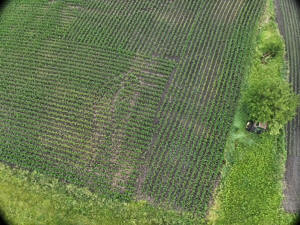|
Farm drones can be valuable in helping farmers keep an eye on
their crops through the growing season. The farmer can carry out
tasks efficiently and effectively with proper preparation. Here
are some of the basic checks needed to make to ensure a safe and
effective flight.
Before Going to the Field
Ensure you are FAA-certified (Federal Aviation Administration).
To scout or complete any farm business purposes, the pilot must
have acquired FAA Part 107 certification. The certification is
valid for two years and is easy to renew.
If your drone has no controller with a built-in flight screen,
use an approved device such as an iPad instead of your phone.
The larger screen will be much easier to see on bright and sunny
days.
Verify with your insurance professional that your farm has
adequate insurance for mishaps caused by drone operations.
Plan your scouting flights before going to the field to
anticipate needs and potential problems with the drone and the
growing crops. Use your sectional maps, apps, and FAA
information (NOTAM Notice to Airmen) to check for restrictions
or warnings. Record your search in your flight log. Many farm
tracts are near airports and military operations areas. Apply
for flight restriction clearances in advance where you have good
data signals.
Update your drone, device (cell phone or iPad), and controller
per the manufacturer's instructions to prevent flight delays at
the field.
Properly connect the correct flight controller for each
aircraft, if you have multiple drones, as mixing them up is
easy. Mark each aircraft and controller, and I advise having
each controller and drone under different emails for account
login.
Check the overall condition of the drone, including the
propellers, and make sure they are properly secured and free of
damage. The body should be without cracks, and batteries should
be fully charged and bulge-free.
Clean the camera lens according to the manufacturer's
instructions. Use a micro-SD card with the U3 designation only.
Complete the necessary calibrations per your manufacturer. Two
critical calibrations, IMU (inertial measurement unit) and
Compass, are needed when flying from a different location than
the original calibration. These calibrations only take a few
minutes to complete, and they will keep your drone safely in the
air and provide for flight accuracy.
Test your drone near the office in a safe place. Do not take off
near trees, power lines, and buildings on the first flight of
the year, as you may be “rusty.”

Make sure your mapping software is up to date, and if you are
going to do a map, it can be easier to set up the flight plan at
the office.
Plan your missions so that you have enough time, as drones can
have potential problems. Assume some of those problems will
occur, so budget time for that. Plan so that you, as the pilot
in command (PIC), do not become stressed out over delays. Stress
causes mistakes, which lead to further delays and are costly. If
flight control problems arise (and they will eventually),
reacting to them calmly will be easier if you start with a calm
mindset.
At the Field
Viewing a field from the air can tell the farmer much about what
is going on by seeing things you can't see from the road or
walking in a field. August is a good month to do this, as many
problems in the field manifest themselves. As time permits,
flights periodically through the growing season are valuable.
Here are suggestions to consider when on-site:
[to top of second column] |

The use of drones for aerial field assessment allows farmers to quickly identify
areas needing attention, optimizing resource allocation and saving valuable
time.

Record the weather, locations, challenges, and other details in
your flight log. Use your weather app to record wind speed and
gusts, cloud coverage, and cloud ceilings, and check for flight
restrictions that might come up in advance at the office. If you
have an accident, proving you acted responsibly is essential.
Determine if you need to avoid obstacles on your flight
controller. Drone obstacle avoidance features are perfect for
safety. However, some drones have been known to avoid a huge
orange ball in the sky known as the sun, which can disrupt your
flight.
Check for other aircraft, such as aerial sprayers, drones, and
machinery in the field or nearby fields. Military operations
areas exist in Illinois and so be aware. As a drone pilot, you
may need to receive permission to fly above fields located in
these areas.
Tell others in the immediate vicinity that you must concentrate
on the flight. Keep your drone flights within sight.
Check your emotional intelligence. Be calm before takeoff and
during any problems. Know your limits, and do not try to do too
much. When you are more engaged emotionally, returning to do the
flight later may be the best decision.
Do a short test flight. Be sure to record flight data from each
flight.
Mapping takes time, and drone battery life is limited. Scout
fields first by looking through your screen and by taking
general photos or videos. This is much quicker and more
efficient. You can always go lower to view potential problem
areas. Make notes on the location of problem areas, and then
review your notes and photos/video back at the office.
Once back at the office, decide whether to do a full field map
with the proper software or whether another inspection of
specific locations is necessary. Some drone models can be used
to set up the RTK (Real-Time Kinematic) systems you use on your
tractor or combine.
Windy conditions in farm fields occur often as wind speeds
approach 20 mph, practice in open areas, and know your drone's
capabilities.
There are many other considerations when making your first scout
flight of the year or even other flights as the growing season
progresses. As drone pilots, getting complacent and skipping
over essential details is easy. Problems and collisions can and
do occur, but careful planning helps to avoid these situations.
The PIC assumes full responsibility for mishaps. Heavy fines and
prison sentences are real consequences for deliberate or
unplanned mistakes. If you are fully prepared for your flight,
field scouting with drones can be very beneficial to your farm
operation.
[Kevin Brooks
University of Illinois Extension Farm Business Management and
Marketing Educator] |